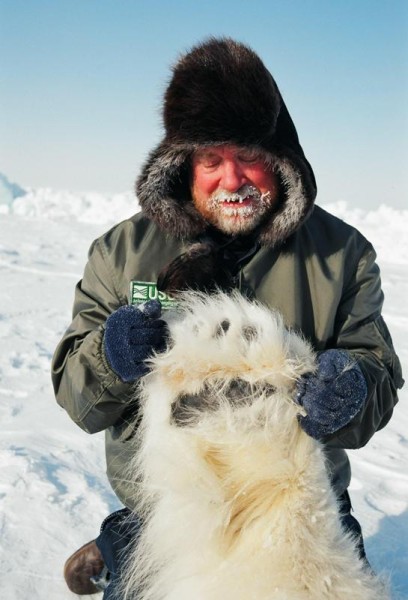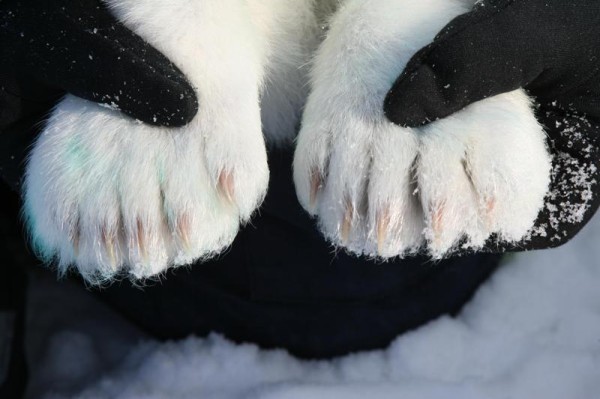Paws and Claws: Polar Bear ‘Foundations’
Do you have polar bear questions? Because we have answers for Polar Bear Week (February 24-28)! Send your questions to [email protected] today, and be sure to tune in next week for our Google Hangout on Wednesday, February 26 at 2:30 p.m. EST and our live Twitter Q&A on Friday, February 28 at 1 p.m. EST to get your answers!
Polar bear paws are impressive, to say the least. Their feet are heavily furred for warmth and their pads are rough for added traction on the ice. Their feet are also quite large, often about 12 inches wide, to match their weight and to spread that weight out over deep snow and thin ice to avoid falling through. Their claws are shorter and sharper than their brown bear cousins on land, measuring up to 3.75 inches including the terminal phalanges (a small piece of bone like our fingertip) or up to 6 inches if you include the first full digit, or entire toe, and the claw. Their claws are also very thick, sharp and curved – the better to grip frozen sea ice or slippery prey, like a ringed seal.

Though their feet look very different from ours, polar bears walk much like you and I, and share aspects of our bone anatomy. (So much so, in fact, that bear bones unearthed during construction are often confused with human remains by the average person!) This is somewhat unusual for predators, many of which rely on being strong runners over longer distances (like cats and canines, which are digitrade, or ‘toe walkers’). Instead the plantigrade, or ‘flat footed’ polar bears have paws designed to carry a heavy frame, good for additional grip, climbing, and even standing upright to gain a sight, height, or scent advantage.
But that doesn’t mean that polar bears paws make them slow: they can sprint in short bursts at speeds estimated around 45 km/hour (30 miles/hour). By comparison, the world’s fastest human, Usain Bolt, is estimated to run up to 43.99 km/hour (27.49 miles/hour) – far faster than your average person, so do not ever try to outrun a polar bear!
Despite their sprinting ability, polar bears use their paws much more for walking. Unlike their terrestrial relatives, polar bears (which live primarily on sea ice) are long distance wanderers, capable of walking some 30 km (19 miles) or more per day for multiple days across jumbled ice and snow. We know that individual bears can walk 80 km (50 miles) in about 24 hours and up to 1,119 km (695 miles) in a single year, thanks to satellite telemetry data (bears wearing GPS collars). Their home ranges, or turf, can be much larger than other bears – stretching from 50,000 square km (19,305 square miles) to over 350,000 square km (135,135 square miles)!
In addition to walking, polar bears’ large paws serve another purpose – propulsion through the water. Adult polar bears are strong swimmers and are quite comfortable in the water at any time of the year (open water is often warmer than outside air temperatures, after all). Polar bears use their front paws to swim and their hind legs to steer, much like a rudder. In 2008, the United States Geological Service tracked a radio-collared adult female polar bear in the Beaufort Sea on a continuous swim of 687 km over 9 days! She then periodically swam and walked on the sea ice an additional 1,800 km. Between her capture in the spring on the ice and her recapture in the autumn on shore, this polar bear lost 22% of her body mass. While they are capable swimmers, there is a trade-off: using more of the fat-stored energy that they need to thrive.
Polar bear paws are designed precisely to meet the challenges and demands of an Arctic lifestyle. And with a coat and body to match, it’s clear that these magnificent bears are uniquely adapted for their Arctic home – and an important reminder of why we need to make sure they have a place to thrive as the Arctic changes.
Help WWF conserve a resilient patch of sea ice for polar bears and their paws: give to WWF’s Arctic efforts and Coca-Cola® will match your donation dollar-for-dollar until March 15, 2014, to a maximum of $1 million USD (Canada and U.S. only).


